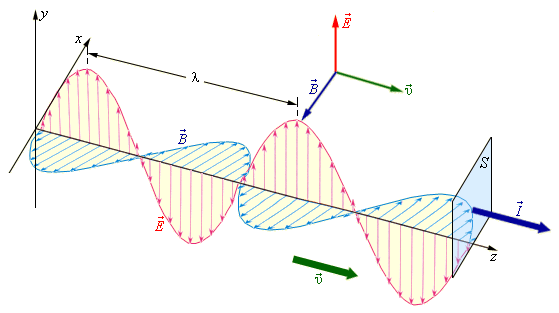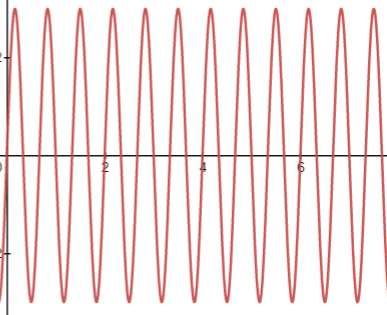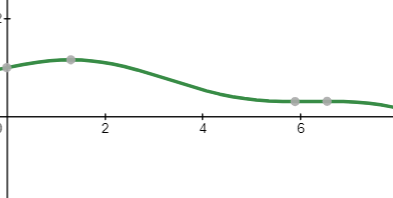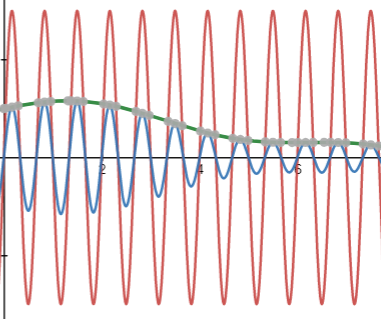Amplitude Modulation
Now we have some basic understanding of how a radio signals (oscillations of electromagnetic field) are transmitted and received.
But, by themselves, these oscillations do not carry any useful information, which can be voice, image, data or any other type of information.
The oscillations of an electromagnetic field are only carriers of the information and their frequency represents the carrying frequency of the radio communication.
Transmitting and receiving information using the carrying radio waves requires certain additional design that is called modulation.
This lecture is about basic principles of amplitude modulation (AM) to transmit sound waves (oscillations of the air or other medium).
Electromagnetic oscillations are synchronous waves of electric and magnetic field forces perpendicular to each other (see "Field Waves" of this topic "Waves") that can be represented graphically as follows

(you can click the right mouse button and open this picture in another tab for better view)
Since these two kinds of forces act synchronously (in phase), we will represent the intensity of the electromagnetic field as a simple two-dimensional sinusoidal graph

At this point we'd like to state that the frequency of the carrier waves represented above should be relatively high as compared to frequency of the sound waves to accomplish successful sound transmission. The reason for this will be obvious after we explain what amplitude modulation is.
Our first task is to convert sound into oscillations of electric current. This is accomplished by a microphone or any other sound capturing device.
Notice that the oscillations of the electric current must represent the sound in its frequency and amplitude. Moreover, real sound is usually a combination of different frequencies of oscillation of air or other medium with different amplitudes, and the corresponding oscillations of electric current should reflect all this multitude of different parameters.
Considering we have accomplished producing an electric current oscillations in some circuit that reflects the sound. Here is a graphical representation of these oscillations:

The next task is to transmit these oscillations.
Experiments show that these oscillations are of too low frequency and not well propagated using any kind of an antenna. Its the high frequency oscillations that needed to do it with some sort of success.
Here comes the amplitude modulation. This method is using the high frequency of the carrier waves produced by an electronic RLC oscillator (red on a picture below), superimposing on its oscillations the changes in amplitude in synch with oscillations of the sound frequency (green on a picture below).
The result is the carrier oscillations modulated by amplitude by sound waves (blue on a picture below):

It should be obvious now why the carrier frequency of radio waves oscillations must be significantly higher than the sound waves frequency. If this difference is not significant, it would be impossible to distinguish the signal of the carrier from oscillations of sound waves.
Sound waves frequencies are those in the range from 20Hz to 20,000Hz (1Hz is 1 period of oscillations per second, which is, actually, sec−1), while the range of carrier frequencies for amplitude modulation (AM range) is from 540,000Hz to 1,600,000Hz (that is from 540kHz to 1,600kHz). Such a difference in ranges assures that the sound waves reflected in the amplitude of carrier waves are distinguishable from the carrier waves themselves.
For example, WCBS radio station in New York broadcasts at the carrier's frequency
f=880kHz=0.88·106sec−1
At the same time, the sound frequency of High A note is 440Hz. That means that for each period of this sound wave the carrier makes 2,000 oscillations.
The higher the sound's pitch (which is, higher frequency of sound waves) - the less difference there is between its frequency and the frequency of the carrier radio waves. With the highest frequency that human ear can hear, which is about 20,000Hz, the WCBS radio waves with frequency of 880kHz are only 440 times more frequent. Generally, it's still sufficient to select the sound waves from the carrier's but some small details of sound waves might be lost. That's why AM radio cannot carry really high fidelity sound, but for regular speech it works fine.
Incidentally, considering the speed of propagation of radio waves is, approximately,
c=0.3·109m/sec,
the WCBS radio waves have the length of
λ = c/f ≅ 341 m
These relatively long waves allow AM radio signals to go around large objects and even be reflected from the ionosphere. As a result, AM radio can be received at a significantly more distant from a transmitter location than waves of a shorter length.
What remains to discuss is a physical implementation of the amplitude modulation.
This implementation involves reducing the amplitude of the oscillations of an electric current in the LC circuit connected to an antenna.
This can be accomplished by adding a variable resistor into a circuit that is controlled by a current that represents the sound waves on the output of a microphone.
There are many different ways to put together such a device, we will leave this to special courses on radio electronics.


No comments:
Post a Comment